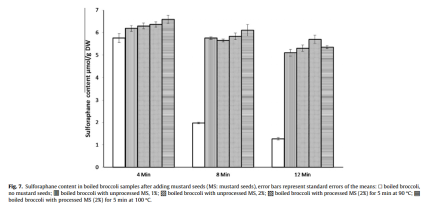One of the benefits that comes from eating cruciferous vegetables like broccoli and purple cabbage is consumption of sulforaphane, a naturally occurring anticancer compound. However, do you know that boiling these vegetables for longer than 4 minutes destroys most of their sulforaphane? Besides eating these vegetables raw (I like purple cabbage raw, but not broccoli) are there any foods that when combined reduce sulforaphane destruction? Luckily, the answer is yes!
In the figure below, the white bars indicate the amount of sulforaphane present after 4, 8 or 12 minutes of boiling. Boiling broccoli for 8 minutes destroys almost 2/3 of its sulforaphane, and after 12 minutes, sulforaphane is ~75% reduced. Adding ground mustard seeds (grey bars) at a relative to broccoli concentration of 1% or 2% restored broccoli’s sulforaphane content almost completely back to initial levels after 4, 8 and 12 minutes of boiling. It’s important to note that a mustard seed concentration of 1%, relative to broccoli translates into 3 grams of mustard seed powder per 300 grams of broccoli! That’s not a lot!
If you’re interested, please have a look at my book!
Reference
Ghawi SK, Methven L, Niranjan K. The potential to intensify sulforaphane formation in cooked broccoli (Brassica oleracea var. italica) using mustard seeds (Sinapis alba). Food Chem. 2013 Jun 1;138(2-3):1734-41.


Great blog! After you sprinkle the mustard seed powder, do you wait a certain amount of time before eating to let the sulforaphane form? Thanks!
LikeLiked by 1 person
After the broccoli is done cooking, I drain the water into a bowl containing a few grams of mustard powder. Then I mix it with the boiled water, and add it back on top of the broccoli. Yum!
LikeLike
So what’s the mechanism here, Michael? As I understand it, the glucoraphanin in the broccoli is converted into sulforaphane by myrosinase when chewing bring the enzyme and substrate together from separate compartments in the cells. Presumably cooking denatures the myrosinase. Does the mustard powder add its own myrosinase back? How does it reach the glucoraphanin inside the broccoli cells? Does it retain its activity in stomach acid?
LikeLike
Love the study, thanks for sharing, Michael. Quick question, hope you can help. I see a lot of experts such as Rhonda Patrick talking about heating the sprouts at 60-70C as a way of improving the sulphoraphane by 2-3 fold. She’s also stating that she’s freezing her sprouts. Which one is it then? Both? If both, which one is first? Freezing, then heating? Looking fwd to your reply.
LikeLike
Did she provide a link to that study? That would help to assess what’s best.
LikeLike